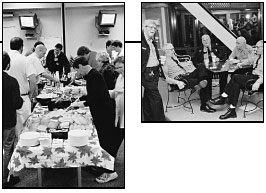DHMC's rollover to Y2K goes off like clockwork
Every New Year's Eve, there's eager anticipation in the wait for midnight to strike. In 1999, with the rollover to a year with a new first digit and three potentially havoc-wreaking zeros trailing behind, there was a measure of anxiety mixed in with the usual anticipation. The media had been covering the "Y2K bug" for months, and though authorities predicted a smooth transition, no one could guarantee the lights would stay on.
Big institutions like DHMC had collectively invested billions of dollars to reduce the danger of Y2K computing mishaps. Dartmouth- Hitchcock began working on the potential problem in 1997. Constance Durham, the institution's Y2K coordinator since 1998, had overseen the preparations—analyzing systems, testing equipment, working with Y2K liaisons in every department. After all the work, on the night she'd been working toward for two years, Durham was confident enough to say that "freezing rain scares me a lot more than Y2K." Still, she admitted, "no one can promise there will be no problems."
Confidence: Nevertheless, a tour of the hospital the evening of December 31 revealed a sense of confidence. In obstetrics, the last baby of 1999—Baby Boy Potter (he'd been born at 12:38 p.m. that day but didn't have a name yet)—was asleep in his bassinet. All the clinical staff felt prepared for Y2K, in good measure because it's part of their training to be ready for any contingency. "We have to do this all the time," said Sherry Calkins of the public affairs office. "We have people's lives depending on the power staying on." In addition, DHMC staffers knew that each of the facility's more than 5,000 medical devices had been tested for Y2K compliance. So the obstetrical nurses were calmly awaiting the arrival of DHMC's millennium baby. (As was the case elsewhere, there was general disregard for the mathematical fact that the new millennium wouldn't really start until 2001.)

|
|
All went well at DHMC during the
rollover to Y2K. Above, several security
guards wait for their shift
change, and, at left, employees
gather in an auditorium to celebrate
the strike of midnight together. |
Quiet: The emergency room, too, was quiet. Staffers here were speculating what the first complaint of the new year would be as they whiled away the time till midnight.
Radiology was deserted. Early that morning, staff had monitored a satellite feed from New Zealand as midnight arrived there. All had gone well, so they went home.
In the hallways, the housekeepers were at work, as they would usually be at this hour. Several security guards had congregated in the food court, waiting for a shift change; they were following their accustomed routines, too.
Engineering was preparing to run the backup generators, but not until 12:30 a.m.—comfortably after midnight. This was one of many "positive checks" that would occur in the first hours of the new year. These checks were partly in response to Y2K but partly just a good maintenance practice.
Communications and information systems were also preparing for their first live checks. They'd run tests with the dates rolled forward, but midnight would present the first chance to check things for real.
By 11:30 p.m., a central auditorium had been set up for a party. Food was laid out and nonalcoholic "bubbly" was on ice. Two television sets were tuned to the countdown to midnight at Times Square in New York City.
DHMC had already had its own countdown: a hugely popular millennium raffle. Each day from December 20 to December 31, someone won a millenniumthemed prize—from hats sporting countdown clocks to Y2K teddy bears. The raffle was a light-hearted note amidst the serious preparations for a worstcase scenario. DHMC had arranged for delivery of the 200 most important supplies if communications broke down. A few weeks' worth of water was waiting in the reserve tank. Each department had established a call schedule for employees.
By 11:45, the auditorium was full. Women and men variously arrayed in jumpsuits, white coats, overalls, or suits were enjoying the food and drink and company as they waited out the last 15 minutes of 1999. When the changeover was just a minute or two away, all eyes focused on the TVs—little windows onto the revelry in New York. With but 10 seconds remaining, everyone —in New York and New Hampshire—joined the countdown. All the planning was about to be put to the test.
As midnight struck in the DHMC auditorium . . . the lights went out. But the TV was still on, showing millions of people embracing in Times Square. It wasn't a Y2K failure. It was a Y2K joke. Someone had seized the millennial moment and thrown the switch in the back of the room. Otherwise, every major function continued without a hitch.
Epilogue: A few weeks later, Constance Durham said a few minor Y2K issues—vendor systems and report headers—surfaced, but none affected operations. The ER's first patient of the new year had suffered a laceration. And the millennial baby was an 8-pound girl, born at 1:30 p.m. on January 1, 2000.
Jonathan Weisberg
If you would like to offer any feedback about this article, we would welcome getting your comments at DartMed@Dartmouth.edu.
